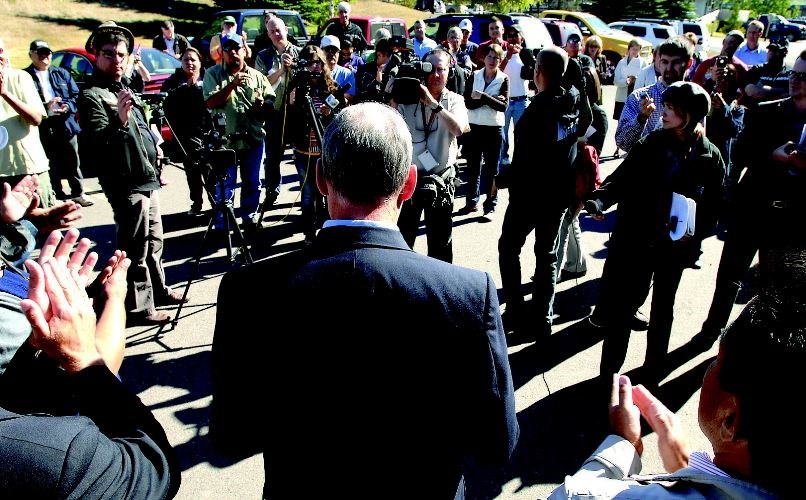BURNS LAKE -- For the first time in a generation, a burnt out mill will be rebuilt in British Columbia.
Hampton Affiliates announced Monday that it intends to rebuild the Babine Forest Products facility in Burns Lake, as along as some key conditions from the provincial government are met.
A crowd of around 50 mill employees and local residents cheered even before Hampton CEO Steve Zika started speaking outside of a government building. They cheered again when he began his address and even louder when he said the new mill could be up and running by early 2014.
"I'm really happy for the citizens of Burns Lake and the citizens around the Burns Lake area that the economic engine will start revving up again here in the Burns Lake area," said Lake Babine Nation Chief Wilf Adam.
The mill was destroyed in an explosion on Jan. 20, killing two workers, injuring 19 others and putting hundreds of people out of work.
With uncertainty surrounding the province's timber supply, it was unclear if the mill would be able to re-open. However with the provincial government willing to restructure its timber licenses and re-evaluate the feasibility of some low quality stands, Hampton decided it was willing to move ahead with the project.
The final decision won't be made until Dec. 3, when Hampton holds a board meeting. Between now and then the company, the province and area First Nations need to hammer out the details of the new timber agreements, but Jobs, Tourism and Skills Training Minster Pat Bell doesn't expect that to be a big hurdle to overcome.
"I think you've got three very willing parties here, who are all sitting here arm-in-arm knowing that we have a task out in front of us," Bell said. "There's always details that we have to work through, so the goal in the next 60 days will be to get that work done."
If everything falls into place, concrete pouring can begin this winter. Logging would begin late next year so that there's timber available when the new mill opens its doors sometime in early 2014.
Nechako Lakes MLA John Rustad said it's rare that mills get rebuilt after they burn down and he believes it's the first time in decades that it's happened in B.C.
Albert Gerow, chief of Ts'il Kaz Koh First Nation (formerly known as Burns Lake Band), said there's been a "cloud of despair" over the community since the explosion but Monday's news is "the best possible outcome."
"The announcement today of rebuilding Babine Forest Products runs deep in our hearts and in our roots," said Gerow, who is also the CEO of the Burns Lake Native Development Corporation . "We can't help but dedicate the new sawmill to the memory of the late Carl Charlie and the late Robert Luggi Jr., and also a tribute to the 19 injured workers, one of whom is still in hospital to this day, and a tribute to sawmill B shift and the whole community of the Lakes District."
Gerow also thanked the hospital staff who were working on Jan. 20 for their help in treating the injured workers.
"Literally miracles happened that night in a small community under tremendous circumstances."
Zika said there's been time over the past eight months when he was unsure of the fate of the mill, and it wasn't until the province came forward with their plan on Sept. 11 that replacing the mill became realistic.
"There's an awful lot of optimistic people here that are glass half-full people," Zika said. "I have to admit I was somewhat nervous given the timber supply and some of the other communities were worried about their sawmills, putting a lot of pressure on the government and that made me nervous, but I always felt it was the right thing to do and we'd find a way to do it."
The new mill will be smaller than the one it's replacing. Zika said the new facility will be able to produce about 2/3 of the 350 million board feet the old mill was able to process, but that the capacity could increase if the timber supply and market conditions supported the addition of a third shift.
In addition to being smaller, it will also be more automated than in the past, which means not all of the workers will be able to get their jobs back. Zika said he wasn't ready to estimate how many people would be employed at the plant, but said it could be anywhere from 50 per cent to 66 per cent of the former staffing level. The old mill had between 200 and 225 employees.
Hampton and the United Steelworkers already have a collective agreement in place from the old mill, which will transfer over to workers at the new mill and discussions are expected to begin soon with the union about any specific changes that need to make in light of new equipment and staffing levels.
United Steelworkers Northern B.C. president Frank Everitt said having fewer jobs may not be a huge concern as some employees may retire between now and when the new mill is operational. He said the company may even need to hire new people, despite the reduced overall staffing level.
Zika wouldn't put a price tag on the new facility, but did say that Hampton will be investing some capital money in addition to the insurance it collected when the mill was destroyed. He promised that the new facility would have top-notch safety features.
"We're going through and looking at state of the art dust systems and cleaning systems," he said. "With the technology comes more people looking at computer screens than actually handling lumber, so the safety infrastructure is going to be better than the older mills or any mills operating in the province."



